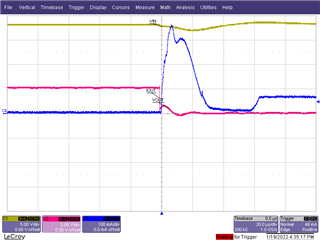Hi Team,
What's the response time for Short-Circuit and Overcurrent Protection? Is it in us range?

BR,
Oliver Tang
This thread has been locked.
If you have a related question, please click the "Ask a related question" button in the top right corner. The newly created question will be automatically linked to this question.
Hi Team,
What's the response time for Short-Circuit and Overcurrent Protection? Is it in us range?

BR,
Oliver Tang
Hello Oliver,
The Fault Detection Table show the reverse current shutdown deglitch time and blanking time.
Below is a scope shot for a short circuit test given the following conditions:
Vin=18V
Vout=5.1V
Iout Limit=50mA

Does this relate to the response time you are looking for?
Best,
Edgar Acosta
Hi Edgar,
Appreciate the feedback then.
1)My customer is using TPS7B7701-Q1 to charge a Ni-Mh battery which requires a constant charging at the beginning. I think they have utilized the current limit capability to realize this purpose. I have a question about the test that since the output is short-circuited, is it an accident that the maximum current just reaches about 350mA which happens to be the highest current that the IC can source? This is a little bit high since the current limit is set to 50mA. For some devices, they're not allowed to withstand such short interval of high current.
2)Additionally, what is the performance of overcurrent capability? Let's say the output current can switch from 80mA to 150mA while the current limit is set to 100mA? Will it take about 60us to decay as well?
BR,
Oliver Tang
Hi Edgar,
It looks like short-circuit condition also accompanies with thermal shutdown. That's why the maximum current is hit and the IC shuts down itself.
BR,
Oliver Tang
Hi Edgar,
Currently this socket is used to power active antenna at customer side. Do you think antenna will suffer from short-circuited condition? If so, antenna module must be able to dissipate the maximum current which can be drawn from LDO, i.e. 300mA, right? More importantly, if the current limit is hit, as described in the datasheet, the output will sustain the current until we re-power the IC, is this correct?

BR,
Oliver Tang
Hi Oliver,
The scope provided was for a short circuit when the device was powered on, and then switched to a short in a controlled manner. Therefore, the LDO output remains low at GND and its not in Thermal Shutdown.
If there is a load transient from 80mA to 150mA per say, the device can be set to limit to 150mA instead of 100mA.
For overcurrent, the response time will be very similar to the short circuit timing.
The peak current that is being experience could vary, it will not always be ~300mA. This is more related to the pass elements. It could be less or even more depending on the application and load conditions.
In regards that antenna will suffer from short-circuited, what could really happen is a cable causing a short circuit, not the antenna itself.
As stated on the data sheet, if current limit is hit, and not assessed, it will remain there and thermal shutdown could be triggered. One method, as you stated, is to power cycle, or pulling the ENx pin low.
Best,
Edgar Acosta